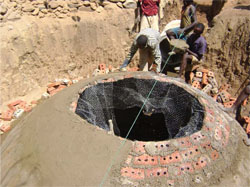19.3.2 Anaerobic biogas reactor
An anaerobic biogas reactor, also known as an anaerobic digester, uses anaerobic digestion to convert liquid wastes and other organic matter into sludge and biogas. The sludge can be used as a soil fertiliser and the biogas can be used for energy to produce heat (for use in cooking) or electricity. This affordable technology can easily be adapted by rural families and communities if appropriate training is given to local artisans and masons in the design and construction of the reactor (Figure 19.6).
The reactor consists of a chamber usually below the ground. It has an inlet for inputs (mainly human excreta) and two outlets (one at the centre for biogas, and the other on one of the sides for outlet of sludge). Addition of animal manure and vegetation will improve the efficiency of the reactor.

Neighbourhoods can join together to share a digester. However, if sufficient wastes are generated, individual households can each have one and get the benefit of biogas production. You should explore if local loaning enterprises could help households install an anaerobic biogas reactor.
19.3.1 Septic tanks
